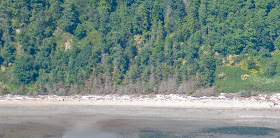I also noted that the trees on the backside of the berm between the berm and the base of the shoreline bluff were mostly dead. Why?
I ventured into the thicket of dead trees with the theory that perhaps the soil had become saturated as the berm had grown and blocked water flow from the slope above and thus killing the trees. However, that theory was killed off when I found no wet ground. In fact the ground was dry despite all the recent rain and the area of the dead trees was covered with thickets of salal, a plant that prefers dry conditions.
The accretion shore feature continued to the north. Its presence jutting out from the base of the bluff seemed a bit out of place, but along shore spits like this are not uncommon.
There was a hint as to what might have been the cause of the accretion shoreform near the shore access at the Fort Flagler State Park. Old pilings in the beach suggested a former structure which would have blocked sediment transport or driftwood causing the shore up drift to build out.
Old pilings for a former pier
Note the large build up of driftwood south of the pier in this photograph
1951 aerial (USGS)
So the likely origin of the accretion shoreform was the past presence of the pier. The wood pilings would block driftwood on the south side but allowed sand to pass through as the south wind generated waves moved sediment generally from south to north. The pier though not used since the 1950s was still present up through 2006.
Oblique aerial view (Ecology, 2006)
My theory on the dead trees was that the accretion shore form is beginning to erode now that the pier has been removed and thus the trees were being inundated with saltwater on a more frequent basis and the beach had narrowed. Nice theory; however, a closer look at the 2006 oblique aerial shows that the trees were already dead before the pier was removed.
Dead trees can be seen all along the base of the bluff (Ecology, 2006)
A view of the 2002 oblique shore aerial shows that the trees alive in 2002.
Same location in 2002 with live trees (Ecology, 2002)
My theories up to this point have not done well! So a new theory is proposed. A large storm surge in 2006 may have been responsible.

This particular storm along the east shore of Marrowstone Island caused significant shoreline erosion that stripped away the toe of the slopes at many locations along the east shore of the island. That erosion set up ongoing bluff failures that took place in the years that followed once the toe of the slope had been eroded. So my theory is that surge of salt water over the berm may have killed the stand of Douglas firs growing between the berm and the toe of the slope.











interesting! enjoyed moving through the various hypotheses
ReplyDeleteInteresting observations. I've also wondered about the timing of beach changes along that stretch - but never pursued it as nicely as you have. My recollection is that much of the beach accretion south of the pier may have been due more to concrete/rock structure on the beach (a ramp of some sort) adjacent to the pier than to the pier itself. But this "groin" began to break down long before the pier was removed, which might have led to the erosion of the southern beach with the pier still standing. I suppose erosion of the backshore might have made the trees particularly vulnerable to the February 2006 event - which likely would have dumped a lot of salt water into that area.
ReplyDeleteI agree with you that the term "accretion beach" is misleading. Bauer used it effectively to raise interest in spits and barrier beaches, and it does capture the notion of a "depositional" landform, but the reality is that accretion beaches often erode, sometimes rapidly.